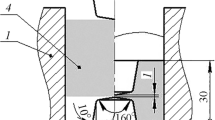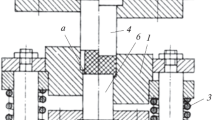The evolution of the stress-strain state and the relative density distribution throughout a porous workpiece in the two-stage hot forging process was studied. The primary stage involved hot deformation of a cylindrical preform with the application of force to its lateral surface to form an intermediate semi-finished product with a cross-section shaped as a truncated cone. Further deformation in the secondary stage involved hot forging of the conical workpiece into a prism. These process stages were simulated using the finite-element method with the DEFORM 2D/3D software package. The starting preform was a cylinder with uniformly distributed porosity throughout the volume. The simulation results revealed significant uneven strains εi across the workpiece following the primary process stage, leading to an area with increased strains εi concentrated near the upper punch. Conversely, the secondary process stage noticeably evened out the strain values across the forged workpiece. This occurred because the severe deformation area in the secondary process stage matched the stagnant area in the primary stage. The proposed two-stage deformation pattern achieved sufficiently high strains (1.3–1.7), allowing the production of forged materials with excellent mechanical properties.







Similar content being viewed by others
References
V.M. Segal, V.I. Reznikov, V.I. Kopylov, D.A. Pavlik, and V.F. Malyshev, Processes of Ductile Structurization of Metals [in Russian], Navuka Tekhnika, Minsk (1994), p. 232.
V.M. Segal, “Equal channel angular extrusion: from macromechanics to structure formation,” Mater. Sci. Eng. A, 271, 322–333 (1999).
T.C. Lowe and R.Z. Valiev, “The use of severe plastic deformation techniques in grain refinement,” JOM, 56, No. 10, 64–68 (2004).
R.Z. Valiev, R.K. Islamgaliev, and I.V. Alexandrov, “Bulk nanostructured materials from severe plastic deformation,” Prog. Mater. Sci., 45, 103–189 (2000).
G. Bagliuk and Y. Shishkina, “The influence of severe plastic deformation on structure and properties of aluminum matrix composite,” in: Congr. Proc. Euro PM 2014 (2014), pp. 21–24.
R.Z. Valiev, A.V. Korznikov, and R.R. Mulyukov, “Structure and properties of ultrafine-grained materials produced by severe plastic deformation,” Mater. Sci. Eng. A, 168, 141–148 (1993).
Ya.E. Beygelzimer, V.N. Varyukhin, D.V. Orlov, and S.G. Synkov, Twist Extrusion—Strain Accumulation Process [in Russian], TEAN, Donetsk (2003), p. 87.
C. Jia, Q. He, J. Meng, and L. Guo, “Influence of mechanical alloying time on the properties of Fe3Al intermetallics prepared by spark plasma sintering,” J. Univ. Sci. Technol. Beijing, 14, No. 4, 331–334 (2007).
R. Eivani and A. Karimi Taheri, “A new method for estimating strain in equal channel angular extrusion,” J. Mater. Process. Technol., 183, 148–153 (2007).
A.P. Zhilyaev, G.V. Nurislamova, B.K. Kim, M.D. Baro, J.A. Szpunar, and T.G. Langdon, “Experimental parameters influencing grain refinement and microstructural evolution during high-pressure torsion,” Acta Mater., 51, No. 3, 753–765 (2003).
V.M. Segal, “Mechanics of continuous equal-channel angular extrusion,” J. Mater. Process. Technol., 210, 542–549 (2010).
Y. Iwahashi, J. Wang, Z. Horita, M. Nemoto, and T.G. Langdon, “Principle of equal-channel angular pressing for the processing of ultra-fine grained materials,” Scr. Mater., 35, 143–146 (1996).
Y. Beygelzimer, D. Orlov, and V. Varyukhin, “A new severe plastic deformation method: twist extrusion/ultrafine grained materials,” Proc. Symp. 2002 TMS Annual Meeting I (Seattle, Washington, February 17–21, 2002), pp. 297–302.
Y. Beygelzimer, V. Varyukhin, S. Synkov, and D. Orlov, “Useful properties of twist extrusion,” Mater. Sci. Eng. A, 503, 14–17 (2009).
S. Sepahi-Boroujeni and F. Fereshteh-Saniee, “Expansion equal channel angular extrusion, as a novel severe plastic deformation technique,” J. Mater. Sci., 50, No. 11, 3908–3919 (2015).
R.M. Imayev, V.M. Imayev, and G.A. Salishchev, “Formation of submicrocrystalline structure in TiAl intermetallic compound,” J. Mater. Sci., 27, 4465–4471 (1992).
Y. Saito, H. Utsunomiya, N. Tsuji, and T. Sakai, “Novel ultra-high straining process for bulk materials-development of the accumulative roll-bonding (ARB) process,” Acta Mater., 47, No. 2, 579–583 (1999).
V.N. Varyukhin, V.Z. Spuskanyuk, N.I. Matrosov, A.B. Dugadko, B.A. Shevchenko, E.A. Medvedskaya, L.F. Sennikova, A.V. Spuskanyuk, and E.A. Pavlovskaya, “Equal-channel multi-angle extrusion,” Fiz. Khim. Vys. Davl., 11, No. 1, 31–39 (2001).
A.P. Maydanyuk, L.A. Ryabicheva, M.B. Shtern, and G.A. Baglyuk, “Evolution of density distribution in equal-channel angular compaction of porous preforms,” Visn. Skhidnoukr. Nats. Univ. Dalya, No. 6 (124), Part 1, 209–213 (2008).
G.A. Baglyuk, L.A. Ryabicheva, T.A. Ryabovol, and V.S. Kurikhin, “Studying the strain state of porous preforms following equal-channel angular pressing,” Fiz. Khim. Vys. Davl., 21, No. 4, 122–128 (2011).
Sh. Kobayashi, S.-I. Oh, and T. Altan, Metal Forming and the Finite-Element Method, Oxford University Press, Oxford (1989), p. 377.
Author information
Authors and Affiliations
Corresponding author
Additional information
Translated from Poroshkova Metallurgiya, Vol. 62, Nos. 7–8 (552), pp. 57–67, 2023.
Rights and permissions
Springer Nature or its licensor (e.g. a society or other partner) holds exclusive rights to this article under a publishing agreement with the author(s) or other rightsholder(s); author self-archiving of the accepted manuscript version of this article is solely governed by the terms of such publishing agreement and applicable law.
About this article
Cite this article
Bagliuk, G.A., Kyryliuk, S.F. & Zlochevska, N.K. Simulation of Two-Stage Hot Forging of Porous Workpieces Involving Severe Plastic Deformation. Powder Metall Met Ceram 62, 427–435 (2023). https://doi.org/10.1007/s11106-024-00404-w
Received:
Published:
Issue Date:
DOI: https://doi.org/10.1007/s11106-024-00404-w




